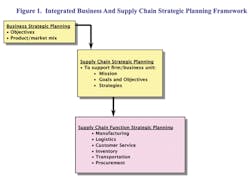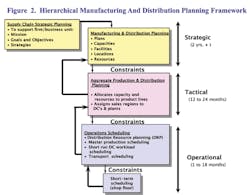Store: Framework Makes a Solid Supply Chain
In today’s competitive global economy, a firm’s market position and bottom-line financial performance are closely linked to its supply chain performance. All too often considerable managerial resources are directed toward planning activities and processes with little payback. What supply chain executives require is the know-how to efficiently and effectively direct their planning activities so the results lead to better business decisions from the long-term down to day-to-day operations.
It starts with a planning framework to organize and manage all major supply chain functions and activities. Frameworks provide methodologies for organizing and managing critical activities such as supply chain strategic planning and project selection, integrated manufacturing and distribution planning, performance measurement and customer logistics and inventory deployment, to name a few. A framework is also required for individual supply chain functions such as transportation, manufacturing and logistics.
Framework Basics
Figure 1 presents a simple framework depicting an integrated process where a firm’s overall business goals and objectives define its supply chain organization’s goals and objectives. Specifically, in its business strategic planning process, a company must address such key issues as overall corporate objectives, market share and profitability goals, and business and product mix targets. Strategic planning decisions relating to overall corporate objectives then drive strategic supply chain plans and decisions. For example, market share and product mix objectives will strongly influence a firm’s supply chain capacity and service strategies.
For example, the manufacturing organization’s plans must address such issues as planned production capacity levels for the next three years and beyond, the location and number of facilities its plans to operate, and so on. Other functions such as logistics, transportation and procurement will face different but similarly critical issues and decisions.
To summarize then, an integrated business and supply chain planning framework to facilitate an aligned strategic planning process consists of three components:
- Business strategic planning – which drives and guides
- Supply chain strategic planning – which drives and guides
- Strategic planning by individual supply chain functions.
The distinction between steps 2 and 3 is as follows: in step 2, the senior leaders of the supply chain organization (i.e., the leaders of all the individual supply chain functions) collectively establish the high-level strategy for their organization. In step 3, each individual supply chain function (e.g., manufacturing) develops a strategic plan for its own organization. This individual plan naturally must support the overall supply chain plan generated in step 2.
A Manufacturing Example
In our hierarchical manufacturing and distribution planning framework, business unit strategic plans have been developed and approved, as have the high level strategic plans of the overall supply chain. Now the manufacturing and distribution functions commence their own strategic planning processes to support the overall supply chain and business unit strategies.
Decisions made at the strategic level place constraints on the tactical planning level. At the tactical level, typical planning activities include the allocation of capacity and resources to product lines for the next 12–18 months, aggregate planning of workforce levels, the development or fine-tuning of distribution plans, and numerous other activities. Within the constraints of the firm’s manufacturing and distribution infrastructure (an infrastructure determined by previous strategic decisions), managers make tactical planning decisions designed to optimize the use of the existing infrastructure. Planning decisions carried out at the tactical level impose constraints upon operational planning and scheduling decisions. At this level, activities such as distribution resource planning (DRP), rough cut capacity planning, master production scheduling, shop floor control scheduling, and many other decisions occur.
A distinguishing characteristic of a hierarchical planning framework is that decisions made at higher planning levels (e.g., the strategic level) place constraints and boundaries on subsequent decisions that will later be made at lower planning levels (e.g., the tactical level). This facilitates aligned decision making across all levels of a supply chain organization and its individual functions from a “top down” perspective. (To strengthen the alignment of organizational decision making, in our book we also discuss various approaches to support integrated planning at all levels including the use of decision support systems, scheduling models and methods, and performance metrics.)
This article is excerpted from “Supply Chain Planning: Practical Frameworks for Superior Performance,” published by Business Expert Press, 2012, and written by Miller and Liberatore. Tan Miller is director of the Global Supply Chain Management Program at Rider University’s College of Business Administration. He’s also a member of MH&L’s Editorial Advisory Board. Matthew J. Liberatore, Ph.D., is director of the Center for Business Analytics at Villanova University.


